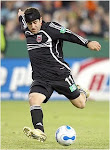
An acceleration-deceleration mechanism in which a blow to the head or the head striking an object results in one or more of the following conditions:
-Headache
-Trouble Sleeping
-Nausea
-Drowsiness
-Vomiting
-Fatigue
-Dizziness
-Blurred Vision
-Balance Problems
-Memory Loss
-Feeling 'Slowed Down'
-Difficulty Concentrating
-Sensitivity to light and noise
-Combative
-Bruce S, Cantu R, Ferrara M, Guskiewicz K, Kelly J, McCrea M, McLeod T, Putukian M. National athletic trainers' association statement: management of sport-related concussion. J Athl Train. 2004;39:280-297.
Concussion data was collected from 180 colleges and high schools throughout the United States in a 2007 study. For the 4,431 injuries reported from 9 sports during one school year, about 9% of these were concussions. Soccer was considered a 'partial-contact' sport by these researchers. In the data collected from soccer players, females had a high rate of concussions than males. In this population of females, concussions amounted for a large number of the total sum of injuries. Among both sexes, about 64% of the concussions suffered were from heading a soccer ball. Contact with another soccer athlete was a more widespread mechanism of injury in male soccer players while contact with the playing surface and forces from the actual ball were more common mechanisms in girls. It was also found that concussions accounted for about 21% of injuries to goalkeepers.
-Collins C, Comstock D, Dick R, Fields S, Gessel L. Concussions among united states high school and collegiate athletes. J Athl Train. 2007;42:495-503.



No comments:
Post a Comment